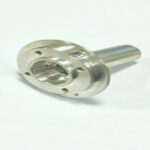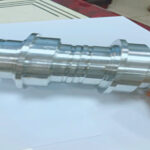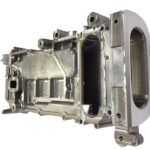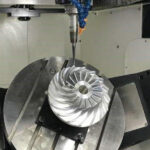
20 Technologies Brief Analysis Of Unmanned Submarine
In order to better carry out national defense strategic frontier technology research, gain insights into technology development trends, and identify technological fog, the trend analysis method of frontier technologies based on neural networks and clustering analysis is adopted to extract technical direction keywords from scientific and technological literature databases, and to consider novelty , Authority, importance and other indicators, calculate the frontier score, and put forward 20 technical trends of underwater robots. Below, cncmachining.wiki will briefly analyze the 20 technologies of unmanned submarine (unmanned submarine is also called underwater robot).
1. Use unmanned submarine to detect marine ecological environment
Table of Contents
The Spanish Institute of Marine Science proposed that platforms such as remote-controlled submarines and unmanned submarines can be used to build underwater surveillance networks to monitor the state of marine benthic organisms. The University of Southampton in the United Kingdom has studied the growth status of cold-water corals using technologies such as remote-controlled submersibles and unmanned submersible high-resolution multi-beam bathymetric images.
2. Self-powered technology of unmanned submarine
Chongqing University has designed an inertial navigation module using friction nanogenerators and combined with an electromagnetically powered satellite positioning module for long-term monitoring of the marine environment by a self-powered unmanned submarine. Arizona State University in the United States proposed that surface or underwater solar cells can be used to power unmanned submersibles or underwater sensor networks to extend endurance. Jiangsu University of Science and Technology has designed an unmanned submarine using piezoelectric devices, which can generate electricity through piezoelectricity while reducing hull vibration. Harbin Institute of Technology has designed an underwater bi-piezoelectric energy recovery system composed of two sets of piezoelectric devices, which can be used in small unmanned submersibles. Huiwen Zhizao is a machining factory with more than ten years of Cnc Machining experience, a manufacturer of underwater robot parts, with complete equipment, CNC turning/milling/grinding/drilling/processing, and partners with parts processing needs are welcome Call for a quote.
3. Adaptive control of unmanned submarine
Huazhong University of Science and Technology proposed a bottom tracking controller that uses Barbalat’s lemma and Lyapunov’s lemma to achieve the stability of the control system, which is suitable for fuzzy adaptive control of unmanned submersibles with saturated actuators. The National Institute of Technology of India proposed a hybrid trajectory tracking control scheme for unmanned submarine vehicles with structural and non-structural uncertainties, using Barbalat and Lyapunov-like lemmas to reduce tracking errors.
4. Path planning of underwater robots using ant colony algorithm
South China University of Technology combined the ant colony algorithm and the A* algorithm to propose a new path planning method for underwater robots, which is suitable for environments with dense obstacles. Xiamen University proposed an improved ant colony algorithm based on particle swarm algorithm for path planning of unmanned submarine vehicles in complex seabed environments.
5. Build the underwater Internet of Things with underwater robots
According to the research of Tianjin University, the underwater Internet of Things is closely related to the development of unmanned submarine vehicles, smart sensors, underwater communication and underwater routing protocols. Kyungpook University in South Korea proposed that an unmanned submarine can be used to connect underwater wireless sensor networks to ground equipment or the Internet. The University of Girona in Spain has designed a docking system for unmanned submarine vehicles with the purpose of building an underwater Internet of Things.
6. Formation control of underwater robots
Northeastern University Qinhuangdao branch proposed a limited-time formation control method for formation control of unmanned submarine vehicles with unknown control directions. Aiming at the time-varying tracking control of the unmanned submarine formation, the Institute of Automation of the Chinese Academy of Sciences proposed an adaptive learning control method using radial basis function neural network. The University of Rhode Island in the United States has proposed an adaptive formation control method using cooperative learning for the formation control problem of unmanned submarine vehicles with nonlinear uncertainty, which realizes the formation control with interchangeable positions.
7. Underwater robot tracking control using reinforcement learning
Northwestern Polytechnical University proposed an adaptive tracking control method based on event-triggered reinforcement learning, which can be used for position tracking of unmanned submarine vehicles in interference environments. Yanshan University has proposed a tracking controller using reinforcement learning for the positioning and tracking of unmanned submarine vehicles. The Michigan Institute of Technology in the United States proposed an online learning algorithm based on reinforcement learning to determine the best trajectory of an unmanned submarine in a confined continuous space (such as under ice). Tsinghua University has proposed a deterministic strategy gradient algorithm based on multi-pseudo Q learning for trajectory tracking of under-driven unmanned submarine, which can improve tracking control accuracy. Tsinghua University proposed a model-free reinforcement learning algorithm based on deterministic policy gradient and neural network for the deep control of unmanned submarine.
8. Bionic design of unmanned submarine
Shandong University established a kinematic model for simulating fish, and studied the influence of different fish models on the flow field. Nanjing University of Science and Technology proposed a pre-strained muscle contraction model, which can be used to study the intermittent gait of fish, and can provide a reference for the design of unmanned submersibles. Harvard University in the United States established a physical model of tuna lateral keel, pectoral fin and other physical models to study the relationship between tuna morphology and sports performance. The relevant conclusions can be used to design a bionic unmanned submarine. The Polish Naval Academy has proposed an underwater acoustic system for biomimetic unmanned submarines to avoid collisions between submarines and low-speed propeller ships such as submarines. The Massachusetts Institute of Technology in the United States designed a soft robotic fish for underwater biological exploration, which can be controlled acoustically by commanders.
9. Underwater sensor network with underwater robots as the mobile edge
Huaqiao University proposed that unmanned submersibles can be used to build underwater wireless sensor networks, and proposed a data collection scheme for sensor networks with unmanned submarines as the mobile edge. Huaqiao University proposes to use the mobility and computing power of edge elements such as unmanned submarine vehicles to collect and analyze data to reduce the data collection cost of underwater acoustic sensor networks. Hohai University believes that when unmanned submersibles are used in underwater acoustic sensor networks, it is necessary to consider the problem of task allocation and load balancing, and proposes a sensor network data collection algorithm that considers partitions.
10. Multi-unmanned submarine coordinated mission
Dalian University of Technology has proposed an underwater cooperative search framework using software-defined networks for the underwater collaborative search problem of multiple unmanned submarine vehicles. Northwestern Polytechnical University proposed to use the overall network performance as the reliability index of the multi-unmanned submarine cooperative system, and studied the influence of temperature and salinity on the system performance. For the underwater three-dimensional environment with obstacles, Shanghai Maritime University proposed a multi-unmanned submarine coordination method using neural networks for cooperative navigation and obstacle avoidance of submarines.
11. Time synchronization of mobile underwater sensor network
For the positioning and tracking of unmanned submarine vehicles, Huazhong University of Science and Technology has conducted a review of research methods such as anchor point deployment, time synchronization and range estimation, and trajectory prediction. Harbin Engineering University proposed a distributed underwater sensor network positioning method using unmanned submarine vehicles as mobile beacons. In response to the propagation delay problem in underwater acoustic sensor networks, Harbin Engineering University proposed a Doppler-enhanced time synchronization scheme for mobile networks, which can be used to promote the collaboration between the nodes of the underwater sensor network. Memorial University of Newfoundland in Canada has proposed a linear method for solving nonlinear equations, which can be used to process positioning information from unmanned submarine vehicles.
12. Power system that uses hydrogen peroxide to reform fuel oil or direct propulsion
The Korean Academy of Science and Technology has proposed a fuel reforming reactor using hydrogen peroxide, which uses the gas and heat generated by the decomposition of hydrogen peroxide to drive fuel reforming, which can be used as an underwater power source for unmanned submarines. The Korea Academy of Science and Technology proposes to combine hydrogen peroxide-driven fuel reformer and proton exchange membrane fuel cell for underwater propulsion of unmanned submarine. Iowa State University in the United States proposed that an unmanned submarine propulsion system using hydrogen peroxide is expected to achieve better acceleration and turning characteristics, and has developed a silica ultrafine fiber/platinum nanoparticle catalyst for efficient catalysis of hydrogen peroxide break down.
13. Underwater wireless charging for underwater robots
For the underwater induction wireless charging of unmanned submarine vehicles, Harbin Institute of Technology proposed a magnetic coupler using dipole coils. San Diego State University in the United States has proposed a wireless charging system with a reverse winding receiver for efficient charging of light unmanned submersibles. San Diego State University in the United States proposed a three-phase wireless charging system that can be used in underwater charging stations for unmanned submarines.
14. Amphibious Unmanned System
North Carolina State University in the United States has designed a fixed-wing amphibious unmanned system that can sail across the air, water and underwater. North Carolina State University in the United States compared the amphibious characteristics of quadrotor/fixed-wing hybrid drones, vertical take-off and landing tail drones, and water-jet assisted take-off and landing drones, and developed a vertical take-off and landing tail drone. The drone prototype can realize cross-domain navigation on land and water.
15. Tracking control of unmanned submarine vehicle using non-singular integral terminal
Shanghai Jiaotong University proposed an adaptive fast non-singular terminal sliding mode control method, which can improve the convergence speed of the unmanned submarine trajectory tracking control method. Shanghai Jiaotong University proposed an adaptive second-order fast non-singular terminal sliding mode control method for the tracking control of an unmanned submarine in the presence of dynamic uncertainty and time-varying interference. Harbin Engineering University uses fast non-singular terminal sliding mode technology to propose a method for controlling multiple seabed resources to detect unmanned submarine vehicles. Shanghai Jiaotong University proposed an adaptive non-singular terminal sliding mode control method for unmanned submarine trajectory control in environments with dynamic uncertainties and external disturbances. Huiwen Zhizao is a machining factory with more than ten years of CNC machining experience. It has complete equipment, CNC turning/milling/grinding/drilling/processing. Partners with parts processing needs are welcome to contact us for quotation.
16. Improve the single beacon navigation accuracy of the unmanned submarine
Harbin Engineering University proposed a single beacon navigation method based on the expectation maximization algorithm, which can improve the navigation accuracy of the unmanned submarine. Russia’s Shengguang Machinery University has proposed a discrete-time linear random system filter algorithm, which can be used for single-beacon navigation of unmanned submarine vehicles. Harbin Engineering University proposes to use the single-input multiple-output model to improve the accuracy of the single beacon navigation method in the unmanned submarine vehicle cluster.
17. Target recognition in sonar image
Shandong University proposed an image segmentation method combining simple linear iterative clustering, adaptive constraints and Markov random fields, which can improve the accuracy of sonar image classification. Tianjin University proposed to combine convolutional neural networks with Markov random fields for the segmentation and recognition of side scan sonar images.
18. Visual positioning of unmanned submarine
Dalian University of Technology has proposed a pseudo 3D visual inertial underwater positioning method that combines depth information with two-dimensional images, which can be used for low-cost underwater positioning of unmanned submarine vehicles. Harbin Institute of Technology proposes a SLAM (real-time positioning and map construction based on stereo vision) positioning method that combines three-dimensional point and line information for the positioning of unmanned submersibles in an underwater environment with fewer feature points.
19. Optimize the environmental sampling task of the unmanned submarine
The University of Southern California in the United States has proposed a task planning and online learning method for the underwater environment sampling task of the unmanned submarine, which can accurately learn environmental data and respond to dynamic environmental changes. Shanghai Jiaotong University has proposed a path planning method using fuzzy logic for the adaptive environmental sampling of unmanned submersibles under the conditions of temporal and spatial changes in the marine environment and limited energy, which can independently select the best route.
20. Deep-sea exploration missions of unmanned submarine vehicles
Hohai University proposed that unmanned submersibles performing deep-sea exploration need to have high-precision positioning capabilities, and the confidence interval model can be used to improve the convergence speed and accuracy of terrain-assisted navigation. The Kyushu Institute of Technology in Japan has proposed a seabed image enhancement method based on Retinex theory for the deep-sea exploration mission of unmanned submarine vehicles, which can enhance the ability of deep-sea target recognition.
Link to this article:20 Technologies Brief Analysis Of Unmanned Submarine
Reprint Statement: If there are no special instructions, all articles on this site are original. Please indicate the source for reprinting.:Cnc Machining,Thank!^^




